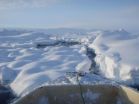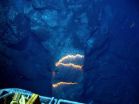(Press-News.org) Cattle ranchers in southwestern Alberta have suspected it for a long time and now, GPS tracking equipment confirms it: wolf packs in the area are making cow meat a substantial part of their diets.
University of Alberta researchers tracked wolves to bone yards, where ranchers dispose of dead cattle, and to sites of fresh cow kills. The study was done over two grazing seasons in 2008 and 2009. The vast study area in southwestern Alberta includes private ranchland and wooded public lands bordering the Rocky Mountains.
Researchers found that during the summer months when livestock was set out to graze on public lands, cattle made up to 45 per cent of the diet for the three wolf packs in the study. This shows a seasonal switch from the wolf's usual pattern of wild prey in the non-grazing season to cattle in the grazing season.
Four wolves in three different packs were outfitted with radio collars that included a standard tracking beacon and a device that collected and saved detailed GPS location data.
When the researchers used the radio signals to locate the general area of the collared wolf, the detailed, hour–by-hour GPS data showing the wolf's movements was uploaded into a handheld device.
The researchers looked for GPS clusters, the locations on the map where the wolves spent a lot of time and went to a total 698 sites where the wolves had gathered. The fieldwork turned up locations where 50 cows were killed.
Researchers calculated that, during the winter months, 85 per cent of the wolves' scavenged (already dead animals) feeding events were at bone yards located on land belonging to ranchers. The researchers noted that often the bone yards were located within a few hundred metres of grazing cattle. The ease of feeding at bone yards can also attract other predators such as grizzly bears and cougars.
Lead U of A researcher, Andrea Morehouse says the most alarming element of the research is that almost 50 per cent of the wolf packs' summer diet was cattle meat. The researchers say this shows the need for management plans in the study area in order to reduce the opportunities for wolves to prey on cattle.
###
The research was published online March 24 in Frontiers in Ecology and Environment.
GPS study shows wolves more reliant on a cattle diet
2011-03-29
ELSE PRESS RELEASES FROM THIS DATE:
Study sheds light on how heat is transported to Greenland glaciers
2011-03-29
Warmer air is only part of the story when it comes to Greenland's rapidly melting ice sheet. New research by scientists at Woods Hole Oceanographic Institution (WHOI) highlights the role ocean circulation plays in transporting heat to glaciers.
Greenland's ice sheet has lost mass at an accelerated rate over the last decade, dumping more ice and fresh water into the ocean. Between 2001 and 2005, Helheim Glacier, a large glacier on Greenland's southeast coast, retreated 5 miles (8 kilometers) and its flow speed nearly doubled.
A research team led by WHOI physical oceanographer ...
Insulite Labs Hires Author and Motivational Coach Katie Humphrey to Help Women Fight Back Against PCOS
2011-03-29
Personal trainer, author and motivational speaker wants women to benefit in the same way that her polycystic ovarian syndrome was transformed
Katie Humphrey knows firsthand about just how miserable PCOS can make a woman's life.
She struggled for years with deeply distressing side-effects of polycystic ovarian syndrome like the lack of a menstrual cycle, weight gain, acne and constant fatigue. Finally, she was diagnosed with insulin resistance-linked PCOS and urged, like many women with this disorder, to take birth control pills and anti-diabetes medication to improve ...
Russian boreal forests undergoing vegetation change, study shows
2011-03-29
Russia's boreal forest – the largest continuous expanse of forest in the world, found in the country's cold northern regions – is undergoing an accelerating large-scale shift in vegetation types as a result of globally and regionally warming climate. That in turn is creating an even warmer climate in the region, according to a new study published in the journal Global Change Biology and highlighted in the April issue of Nature Climate Change.
The Great Russian forest, which includes much of Siberia, is the size of the contiguous United States. It has experienced significant ...
India releases tiger numbers as experts convene
2011-03-29
New Delhi, India – The Indian Government today released new tiger population numbers for the first time since 2007, indicating that numbers have increased in the country that has half of the world's remaining wild tigers.
The government estimated current tiger numbers in India at 1,706, up from 1,411 during the last count in 2007. However, the 1,706 figure includes an additional tiger reserve in the count, the Sundarbans, that contained 70 tigers. This area was not counted in 2007.
Therefore, when comparing the previous survey with the current one, the official estimate ...
Greengrade and LEEDuser Announce Integration Partnership to Improve LEED Process Efficiency
2011-03-29
Greengrade, a collaborative online LEED management software tool that allows project teams to communicate, track, and manage LEED project information, today announced a new feature allowing users to access LEED information directly from LEEDuser. LEEDuser helps certify building projects through the key commercial and institutional LEED rating systems, with tipsheets, checklists, sample documentation and forms, forums, and more.
"LEEDuser is all about saving time and money on LEED projects by providing the insights and help design and construction professionals need, ...
Analysis suggests cancer risk of backscatter airport scanners is low
2011-03-29
Calculations by researchers at the University of California, San Francisco and the University of California, Berkeley estimate that the cancer risk associated with one type of airport security scanners is low based on the amount of radiation these devices emit, as long as they are operated and function correctly.
"The doses are low – extremely low," said Rebecca Smith-Bindman, MD, a professor of radiology at UCSF, who made the calculations with Pratik Mehta, an undergraduate at UC-Berkeley. "The amount of radiation in these scans is so low that you don't have to be concerned ...
Twinkle, twinkle, quantum dot -- new particles can change colors and tag molecules
2011-03-29
COLUMBUS, Ohio – Engineers at Ohio State University have invented a new kind of nano-particle that shines in different colors to tag molecules in biomedical tests.
These tiny plastic nano-particles are stuffed with even tinier bits of electronics called quantum dots. Like little traffic lights, the particles glow brightly in red, yellow, or green, so researchers can easily track molecules under a microscope.
This is the first time anyone has created fluorescent nano-particles that can change colors continuously.
Jessica Winter, assistant professor of chemical and ...
Bixby Land Company Acquires $58 Million in Industrial Properties
2011-03-29
Bixby Land Company, a leading commercial real estate operator and investment manager based in Orange County, Calif., has purchased four Class A industrial properties totaling approximately 850,000 square feet. The acquisitions increase Bixby Land Company's wholly-owned portfolio to more than 5 million square feet and point to Bixby's increasing investment activity as California property markets show signs of improvement.
"Our investment in these high-quality properties is a reflection of our confidence in the recovery of commercial real estate, in particular the industrial ...
The Birth of a Novel: Josie Brown's THE BABY PLANNER is Nurtured by the Profession it Touts
2011-03-29
Conception is a blessed event, be it a child's, or a new book. That is novelist Josie Brown's contention. She should know. The idea for her fourth novel, The Baby Planner [Simon & Schuster/Gallery Books]--about a childless woman who channels her nurturing instincts toward her pregnant clients--was born in the reception area of her mammogram center.
"I picked up the only reading material available: a local parenting magazine," explains Brown, who lives in the San Francisco Bay Area. "My own children are older, so it wasn't necessarily something I felt might interest ...
Deep-sea volcanoes don't just produce lava flows, they also explode!
2011-03-29
Between 75 and 80 per cent of all volcanic activity on Earth takes place at deep-sea, mid-ocean ridges. Most of these volcanoes produce effusive lava flows rather than explosive eruptions, both because the levels of magmatic gas (which fuel the explosions and are made up of a variety of components, including, most importantly CO2) tend to be low, and because the volcanoes are under a lot of pressure from the surrounding water.
Over about the last 10 years however, geologists have nevertheless speculated, based on the presence of volcanic ash in certain sites, that explosive ...




